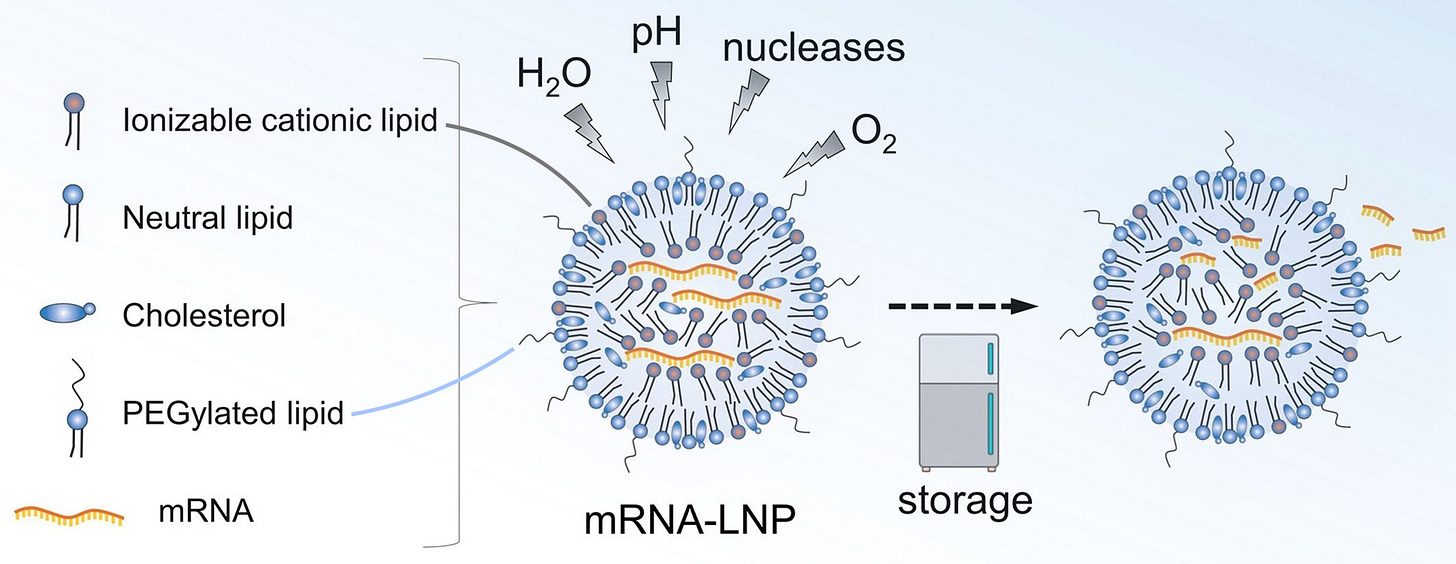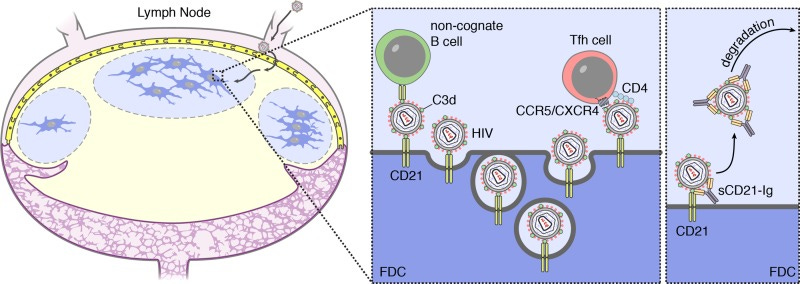The 60 Day RNA Mystery: Spoiler / Summary
Brief overview of the likely "innocent" explanation for lingering spike and Covid vaccine RNA in germinal centers, and new concluding remarks.
The following summary and concluding remarks are all covered under Spoiler Alert, as they give away the solution to the “mystery” of lingering 60 Day RNA without showing how the mystery, piece by piece, was worked out.
For lay readers especially, I recommend reading from Part 1 instead, so that all the elements of the solution can be presented and discussed in context.
Readers who have already finished Parts 1 and 2 will find new concluding comments at the bottom of this post. With that out of the way…
Mechanism for long-term retention of spike protein and RNA in germinal centers after 2nd dose of mRNA Covid vaccines.
Spike protein: Normal antigen retention by Follicular Dendritic Cells in germinal centers forming / refining anti-spike antibody response
Localization of spike in germinal centers is consistent with long-term retention by FDCs, and not novel delivery by Antigen Presenting Cells encountering spike in the body - i.e., this is “true lingering” in germinal centers.
Long-term retention of antigen in germinal centers / FDCs has been observed for decades, and was once considered a correlate for more effective antibody responses. This was never upturned; instead, recent research has simply neglected the phenomenon, though that is finally reversing.

Bachmann, et al. (1996.) Fig. 4. (Image orientation differs between photographs.) In vivo retention of antigen for well over 60 days is entirely plausible based on the current research finally looking back into the topic.

Heesters, et al. (2013) Graphical Abstract. (annotated)
RNA: Likely retention of entire LNPs by Follicular Dendritic Cells in germinal centers forming / refining anti-PEG antibody response
As above, novel delivery by Antigen Presenting Cells is not supported by localization of RNA in Fig 7. This is “true lingering.”
Anti-PEG antibodies are likely elicited by initial injection. Röltgen, et al. only looked at lymph node samples after the 2nd dose, when previously primed anti-PEG antibodies could affect immune response.
Attachment of anti-PEG antibodies to LNP PEG chains leads to formation of C3 complexes and B Cell delivery of complex-decorated LNP to FDCs for novel / amplified germinal center response.
Retention of entire LNPs by FDCs is plausible based on established (but, again, limited) study of complex-decorated HIV FDC retention.
FDC’s have uniquely “inert” recycling compartments which would not be acidic enough to charge the ionizable lipids responsible for RNA escape in normal cytoplasm. Thus, they are capable of long term preservation of the whole / closed LNP structure.

Schoenmaker, et al. Graphical Abstract. (pointer lines added)
Long term durability of RNA inside LNPs at body temperature is plausible based on data from Roesler, et al., and the LNP design in general.
Examination of Röltgen, et al.’s findings in Part 1.
Full discussion and references for the above FDC retention mechanism Part 2.
Conclusion
Röltgen, et al.’s findings are, at best, completely neutral in so far as demonstrating that LNPs or spike are retained anywhere outside of lymph node germinal centers, nor do they suggest a “diseased” germinal center condition (despite the HIV resemblance; it is plausible that many types of virus and vaccine genes get “stuck” in germinal centers in this way, but little research has taken place to check). It may still be true that these things are occurring, but this evidence doesn’t reflect that outcome.
As germinal centers degrade, captured spike and LNPs/RNA will likely dissipate and be targeted for immune destruction. However, there are still possible links with long term effects from Covid vaccines or from infection with SARS-CoV-2. Again, this may also be true of other types of infections and vaccines, and has not been well-researched.
Long-term retention of spike in germinal centers suggests that the spike protein is inherently capable of producing a long-term-exposure-equivalent antibody response from a single exposure (similar to VSV in the VSV-mouse model studied by Backmann, et al.). Second and later doses are potentially adding nothing meaningful to the initial antibody response in terms of efficacy against severe infection, regardless of what antibody titers look like. Obviously, real-life data is unlikely to support this due to unhealthy user bias for those who elected to take the first dose but not the second, presumably due to medical downturns and adverse events.
This evidence further suggests that single doses of mRNA Covid vaccines frequently result in formation (or increase) of anti-PEG antibodies - though this is a small and unique sample (biopsies for breast cancer staging).










Essentially, "more research is required". It really is fascinating seeing you put together this information. We do have to keep in mind that the pseudouridine residues are likely to alter the longevity of the mRNA as it prevents it from being targeted by nucleases (same with the poly-A tail). I wonder if radiolabeled PEGs or mRNA may help with figuring this out.
But for now, it is "trust but verify" and "wait for further evidence".
This series is brilliant! A bit taxing for the non-scientist (retired systems/software engineer here), but still accessible (and even entertaining) for those with an interest in figuring it out. My mind has gone through a number of theories and sources over the last 2 years. Glad I came upon your sub stack!